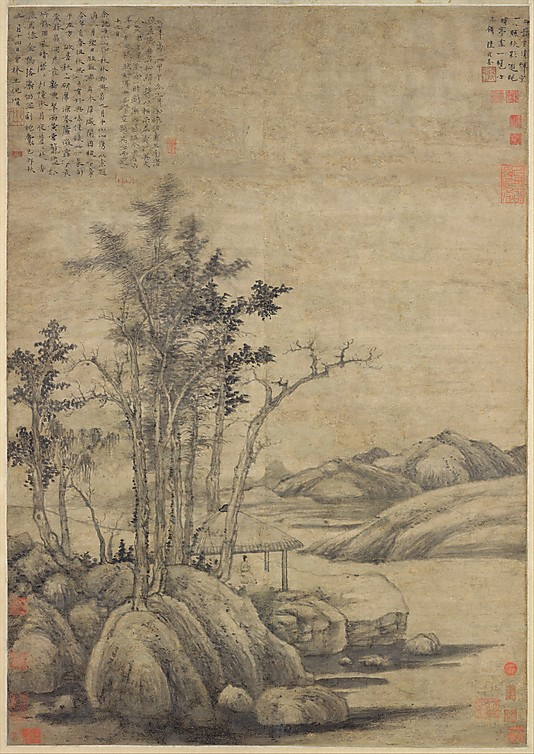 This landscape painting is believed to be the earliest surviving work of the Chinese artist Ni Zan (1301-1374). The scroll measures 271.5 x 91.1 cm. Also referred to as Ni Tsan, this artist is considered along with Huang Gongwang (1269-1354), Wu Zhen (1280-1354), and Wang Meng (1308-1385) as the “Four Great Landscape Masters of the Yuan Period”.
This landscape painting is believed to be the earliest surviving work of the Chinese artist Ni Zan (1301-1374). The scroll measures 271.5 x 91.1 cm. Also referred to as Ni Tsan, this artist is considered along with Huang Gongwang (1269-1354), Wu Zhen (1280-1354), and Wang Meng (1308-1385) as the “Four Great Landscape Masters of the Yuan Period”.
Many of Ni’s paintings were done while traveling. His hosts would often request a painting from Ni in exchange for their hospitality or as a symbol of their friendship. The artist would typically include long inscriptions which would include a dedication and describe the event. Enjoying the Wilderness in an Autumn Grove was originally signed in 1339. It included a second inscription by Ni, written in 1354, which might indicate that Ni visited the family twice. Although not mentioned in any other references I could find, since Ni is often said to have been known for landscapes devoid of humans or animals, it would seem this may be one of his only works which does include a human figure. The scholar is however painted in such a way to almost be invisible within the landscape he is contemplating.
I found a partial translation of one of the poems though it is not explained whether it is from the first or second inscription…
In the bright days, bamboo wave in the breeze;
In the dark nights, parasols of fir hold up the moon.
Burning incense I use [a censer in the form of] a gilded duck;
Gathering scattered petals, I place them inside my pillow.
This work follows the more traditional composition of the time and clearly depicts the scholarly ways Ni and the literati of the day espoused – scholarly contemplation done in isolation. One art scholar proclaimed this painting is yi qi – “an aloof and untrammeled elegance, for which Ni Zan has been credited as the best painting since in the history of art in China.” It clearly shows the Daoist leanings of the artist as it depicts the ideal setting for Daoist meditation.
It’s a shame that time has so discolored the paper of this old scroll. What were probably areas of contrasting shades of ink are now faded and somewhat melted into the paper. Even after almost 700 years, this landscape painting has a serene a meditative feel about it. The tall trees and substantial landscape along with Ni’s almost there quality of the scholar serve to make one wonder about how small we humans are and how grand the world around us really is.
Please visit our biography of Ni Zan to learn more about this famous Chinese landscape painter and see more examples of his work.